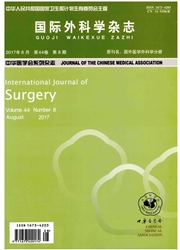

 中文摘要:
中文摘要:
目的探讨加速康复外科(ERAS)理念在肝细胞癌(肝癌)肝切除围手术期中的应用价值。方法回顾性分析2010年1月至2014年5月在安徽省立医院行肝切除术治疗的393例肝癌患者临床资料。患者均签署知情同意书,符合医学伦理学规定。根据患者围手术期处理方法不同,分为ERAS组和对照组。其中ERAS组128例,男108例,女20例;平均年龄(53±11)岁,采用ERAS理念进行围手术期处理。对照组265例,男226例,女39例;平均年龄(54±11)岁,采用传统方式进行围手术期处理。观察两组术后情况。两组术后住院时间、住院费用等数据比较采用t检验,率的比较采用Pearson∥检验、连续性校正,检验或Fisher确切概率法。结果ERAS组患者术后早期下床活动率、术后48h疼痛数字等级评定量表(NRS)评分≤3分患者百分率分别为47.7%、74.2%,明显高于对照组的9.8%、32.8%(Z=71.717,59.464;P〈0.05)。ERAS组肠道通气时间为(39±16)d,明显早于对照组的(47±17)d(t=-3.306,P〈0.05)。ERAS组术后住院时间、住院费用分别为(7.8±2.5)d、(2.7±0.8)万元,明显少于对照组的(8.7±4.2)d、(2.9±1.0)万元(t=-2.677,-2.090:P〈0.05)。结论ERAS理念应用于肝癌肝切除围手术期中是安全、有效的,其可在不增加死亡率、再入院率的基础上加快患者术后康复,缩短住院时间,减少住院费用。
 英文摘要:
英文摘要:
Objective To investigate the application value of the concept of enhanced recovery after surgery (ERAS) in the perioperative period of hepatectomy for hepatocellular carcinoma (HCC). Methods Clinical data of 393 patients with HCC who underwent hepatectomy in Anhui Provincial Hospital between January 2010 and May 2014 were retrospectively analyzed. The informed consents of all patients were obtained and the local ethical committee approval was received. According to different processing methods during perioperative period, the patients were divided into the ERAS group (n=128) and control group (n=265). In the ERAS group, 108 cases were males and 20 females, aged (53±11) years old on average, and the patients received the treatment with the concept of ERAS in the perioperative period. In the control group, 226 cases were males and 39 females, aged (54±11) years old on average, and the patients received the traditional treatment in the perioperative period. Postoperative conditions were observed in two groups. The data including postoperative length of hospital stay and hospitalization expense between two groups were compared using t test. The rate was compared using Pearson Chi-square test, continuous correction Chi-square test or Fisher's exact probability test. Results The percentage of early postoperative off-bed activity and pain numerical rating scale (NRS) score ≤ 3 at postoperative 48 h in the ERAS group was respectively 47.7% and 74.2%, significantly higher than 9.8% and 32.8% in the control group (Z^2=71.717, 59.464; P〈0.05). The intestinal exhaust time in the ERAS group was (39±16) d, significant earlier than (47±17) d in the control group (t=-3.306, P〈0.05). The postoperative length of hospital stay and hospitalization expense in the ERAS group was respectively (7.8±2.5) d and (2.7±0.8)×10^4 yuan, significantly less than (8.7±4.2) d and (2.9±1.0)×10^4 yuan in the control group (t=-2.677, -2.090; P〈0.05). Conclusions It is
 同期刊论文项目
同期刊论文项目
 同项目期刊论文
同项目期刊论文
 期刊信息
期刊信息
